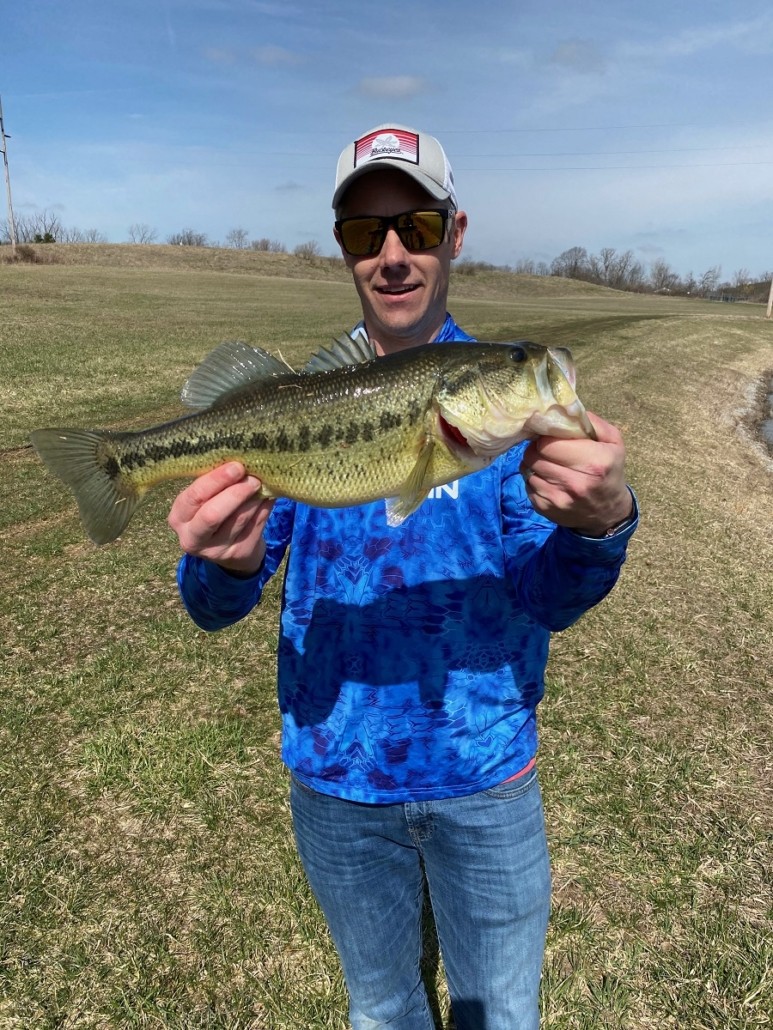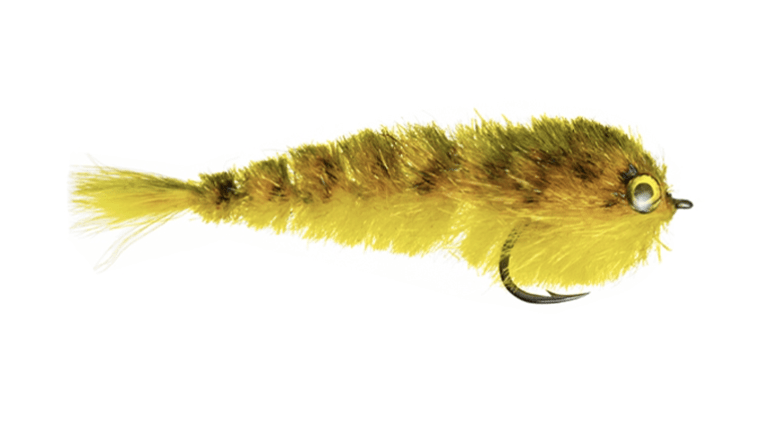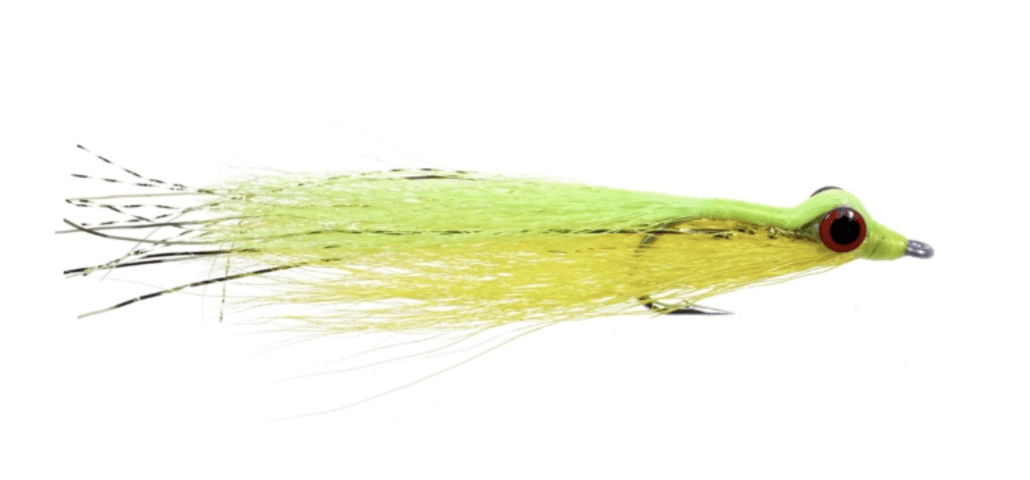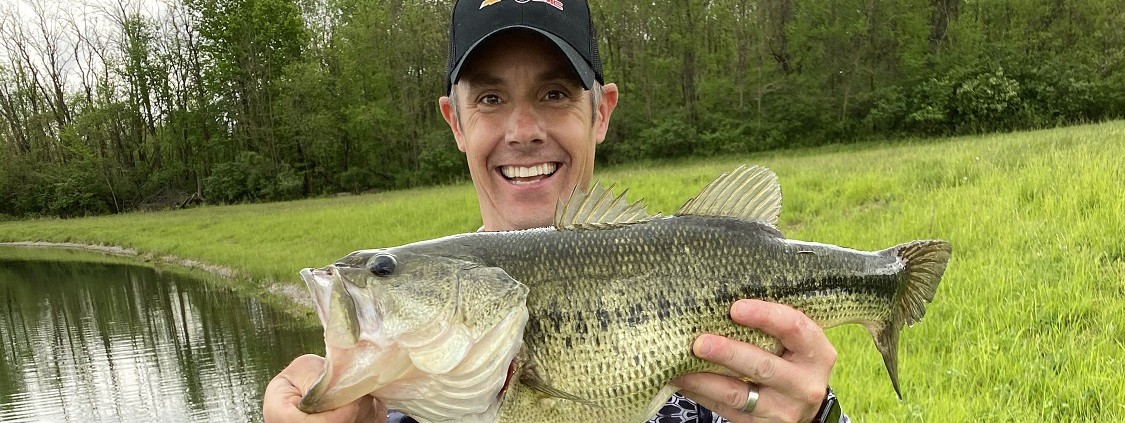Spring Fly Fishing for Largemouth Bass
by Drew McCartt with experienced bass anglers Max Reiner and Steve Moore
Fly Fishing for Largemouth Bass | An Interview with Two Seasoned Fly Anglers
Ahh, the celebrated largemouth bass. This highly sought, aggressive sportfish is surely the most widely recognized fish for anglers of all abilities, especially for the eastern half of the U.S. The species is truly a legendary fishing target – in fact, ask the more seasoned circles of bass fanatics who for years have referred to the big ones as hawgs, pigs, toads, lunkers, studs, bruisers, and of course, wallhangers! Few other species have that killer instinct reputation with bragging rights status for the angler.
At Briarwood Sporting Club, a 440 acre private fishing club and hunting preserve located in Logan County, Ohio, you can find these impressive fish in all of our ponds and lakes, from North Lake to Perch Pond. With the water temperatures rising above 55 degrees right now, largemouth are ready to eat (actually, devour) as we roll into late April!
Fly Fishing for Largemouth Bass?
For me and many other anglers, there is no more exciting way to land a hawg than with a fly rod. Sure, most people can catch a bass with spinning or casting gear, and certainly live bait. But with a little expert guidance, you can gain the bragging rights of getting that lunker while fly fishing for largemouth bass here at your club – and the excitement only fly gear provides!
For that expert guidance, I turned to two proficient anglers (who also happen to be Briarwood members) who have a wealth of largemouth bass fly fishing experience. They each have more than 35 years of angling for bass and many other species under their belt. Max Reiner and Steve Moore were happy to share their experience, wisdom, and gear tips.
Max Reiner started fishing at the age of 3 and caught his first fish, a hybrid bluegill, in a small pond. He was hooked immediately. He has fished around the country and beyond for many, many species with equipment he designs and builds. He has also served as a professional fishing guide. His favorite species to pursue by fly are carp and musky.
Steve Moore started fishing when he was 5 and his first fish was a bluegill as well. Since then, he has seized every opportunity to fish with a passion, using his hand-tied flies – many of his own design. He has closely studied the nuances of fish behavior and how seasons, weather, and water quality are so closely connected to fishing success. His favorite species to pursue by fly is the steelhead.
Interviewing the Fishing Experts
“What is the most unusual place you’ve fished?”
Max: That is an easy answer for me – several unnamed atolls in the Pacific for dogtooth tuna and giant trevally.
Steve: I would love to say something neat and obscure such as fishing native brook trout in Labrador Canada, but I’m actually kind of lame – it is my backyard. There is a pond in my neighborhood that when flooded will frequently back up into my yard. This creates a perfect situation for largemouth bass to swim up the fake channel looking for all kinds of new food sources, as well as my flies, apparently.
“I know you guys have some intriguing experience like guiding and making your own fly gear – please share more.”
Max: I started guiding when I was 20 in Alabama, when I should have been in my college accounting classes in Ohio. I did two several-month stints guiding for red fish and speckled trout in the Gulf region of Alabama and Louisiana. Mostly sight fishing and skinny water.
My experience building lures, flies, and rods came out of necessity because at the time a lot of the species I was chasing did not have properly designed tackle available from mainstream manufacturers. It has morphed into building beautiful tools for anglers that take a lot of pride in their gear and are pursuing a specific and hard-to-catch species. I really enjoy making flies and lures, as well as rods. I have been able to share this passion with members I have met at Briarwood.

Steve: Tying flies is one of my favorite things to do; almost equally as much as the fishing itself. I’m always looking to both innovate with new patterns, as well as improve on old favorites. I particularly enjoy tying up a small box of flies the night before a trip to the water, which will be specific to the conditions and fish I will be targeting. Few things are as satisfying and enjoyable to me as catching a fish on a fly that I tied myself – especially some new and creative ones I designed like my latest I call the “flypala.”
“What is it about the largemouth bass that’s so appealing to you as an angler?”
Max: I would say accessibility, its range in Ohio and the Midwest, combined with the ability of the species to live in lakes, streams, and rivers of varying water quality and temperature. Their range of forage and how they can be caught is equally appealing. And on a personal note, I can’t understand any angler not thoroughly enjoying a largemouth blowing up on a top water fly! On a calm morning at Briarwood, there is nothing more awesome than that water breaking open and a hawg taking your topwater fly.
Steve: The appeal of catching largemouth bass to me is quite extensive. They are an aggressive species that is widely available geographically. You can fish for largemouth bass in nearly any pond, lake, or ditch as well as in the rivers. And this certainly is true at the Briarwood Sporting Club. This makes it a familiar fish that you can become quite adept and skilled at catching. There is also a very versatile set of tactics to use, particularly topwater, which can keep the fishing always fresh and fun. The visual display of a popper getting taken down by a bass is something to be seen.

Largemouth bass are also appealing in that they are a great combination of hard enough fight, while still being low maintenance. By this, I mean that you don’t need to bring special tools for the trip such as a big net, long pliers, or a hook cutter like you might need with say pike or muskie. They are also not as delicate as trout in that they are not as sensitive to playing hard on the line for too long, requiring more highly oxygenated water, or being better off caught in a specific set of water temperatures. This does not mean to handle bass carelessly or with less respect, however, they are hardy enough to both survive about anywhere and be fished for with ease.
“Why is it special for you to catch largemouth on a fly rod? What’s different about it?
Max: A fly rod is an extremely effective tool for pursuing largemouth bass. Even anglers who mostly fish conventional tackle are realizing the effectiveness of a fly rod, which is drawing people into the sport of fly fishing who otherwise would have no interest in it. A fly’s ability to suspend, breathe, and pulsate in a natural manner is extremely lifelike and enticing to any predators including bass. And there are times when fish are in a negative mood and not truly feeding where a fly works better in getting fish to strike versus conventional methods.
My best memory of fly fishing is not actually a fly fishing memory, but a memory of a very well-respected long time bass angler taking me when I was in 6th grade to fish for bass on Lake Okeechobee. The fishing was good, but the experience left an indelible mark on the techniques and the drive to catch true trophy sized fish. It drove me from a young angler pursuing any fish to an angler who wanted to catch trophy class fish.
Steve: The whole experience of fly fishing for largemouth bass is just more fun in general than fishing with conventional gear. I enjoy the selection of the fly, deciding how I want to present it, and what actions I can manifest to entice a strike. One of the things that I hear is that conventional lures will out-fish flies. However, I would have to disagree. With the right fly, the movement and undulation of the materials in the water in many ways can be as appealing or more so than anything that can be presented with conventional gear, if it is fished properly. Many of the conventional lures that work can translate to the fly rod. You can tie and fish flies that mimic things like wacky rigged worms.

Also, you can certainly jig for bass, and modern streamers provide a more realistic baitfish swim action than anything I have seen in a store or online. I’ve even begun tying fly versions of conventional lures such as the “flypala” which has worked just as well as any Rapala that I used to throw. The gap between the two styles is razor thin with modern materials, so to me what it comes down to is the enjoyment of the fly casting stroke along with the introduction of countless options of how to control the fly in the water. Mixing up full sink lines, sink tips, or floating lines along with the presentation allows limitless choices of how I want to fly fish for bass on any particular day.
For me the most memorable experience was just a particular day last spring when all possible factors seemed to work in my favor. The temperature was nice, it was a slightly overcast day, and the fish were in pre-spawn mode and almost overly aggressive. I apparently had just the fly they were looking for (a chartreuse feather game changer). Within just a 90-minute window of fishing a local lake near my home, I caught 23 bass, some of which were quite sizeable. Seemingly every single cast produced another take. It reinforced in me why this species can be so fun – and certainly on a fly rod. I hardly moved, and yet they just kept eating my fly over and over again. Trout would have spooked and likely moved on after the first fish or two. I would not have had access to that kind of fishing with other species in most cases. I am sure the experience would have been the same at Briarwood that day…perhaps better!
Springtime Fly Fishing for Largemouth Bass
“When will the bass start hitting – conditions, water temp, etc.?”
Max: We regularly catch bass through the ice in water as cool as 38 degrees using active methods like jigging. But for spring fishing, they will start hitting with the water temperature at 50 degrees like it is in most places here in and around Ohio. Catching bass is all about finding where the fish will be in the current conditions. For spring, find places where water is flowing into a larger body – the bass like the warmer water entering the system. At Briarwood specifically, the water inlets at the North Lake and Pine Lake will hold many fish looking for forage coming into the lakes. With the water hitting 55 degrees now, they are starting their pre-spawn movement to shallower spawning grounds.
Steve: Bass are starting to hit more frequently now in most places in Ohio and surrounding states. They are actually fishable year round; however, the bite picks up in March–May as the spawn season commences each spring. We are entering one of the most productive time periods for catching this species in the entire year.
When the water temperature hits the 50 to 55 degree range, as they are now, the bass bite will pick up as they enter pre-spawn mode. The fish begin to actively forage to get ready for the spawn period. Fishing won’t be lights out at these temps just yet, but it’s a lot better than it was the last few months.

Once the water hits the 55 to 68 degree range, the spawn will kick off and the bite is about as good as it gets all year. The bass will be aggressive – females eat for spawning purposes and the males eat to defend the nests. This temperature zone will produce some of the most aggressive hard takes that you can get, even while fly fishing for largemouth bass. We’ll likely see this phase kick off here by mid-April in Ohio.
“What rod weight, lines, and leader size should anglers use while fly fishing for largemouth bass?”
Max: Anything from a 6- to an 8-weight. The biggest leap of technology in this field in my opinion is the array of fly lines that can help you cast long distances accurately, and help you turn over even the most wind resistant flies with ease. Lines such as the Rio Bass Line, Rio Big Nasty Fly Line, Scientific Anglers Bass Bug, and Jungle Titan offer a varied amount of floating, intermediate, and sinking lines to cover all fishing conditions. As for leaders, the biggest mistake I see trout anglers fishing for bass make is leader length. A 9-foot trout tapered leader is inefficient at turning over a large, wind-resistant or heavy bass fly. A simple 6-foot leader with a 60-lb butt section going down to a 15 to 20-lb fluorocarbon tippet will do the job.
Steve: Rod weight is by preference; however, I would not go less than a 5-weight. For largemouth bass, I generally use a 7-weight myself as it presents the most utility. It really comes down to the flies you plan to present. If you’re throwing nymphs or small jigs, the 5-weight will be just fine. For long streamers or heavier flies with weighted dumbbell eyes, you are going to likely want to increase the rod weight. I use the 7-weight because it allows me to do just about anything, and I never feel limited in my fly box.
With regard to leader size, the bass are fortunately not “leader shy” like many other species including trout. I generally use a 5- to 7-foot leader and have adequate test rating to deal with pulling strong fish out of heavy structure if necessary. I use 15 to 20-lb mono, but will go stronger when conditions necessitate it. When fishing streamers, in particular, I’m less focused on things such as the taper of the leader, and often just tie on a single 5-foot piece of 20-lb mono.
“What about your preferred bass flies…”
Max: As for surface flies while fly fishing for largemouth bass, I choose double barrel poppers, Sneaky Petes, and Dahlburg Divers –good for the “witching hour”.
My choices for sub-surface bass flies include Clouser minnows and Chockletts game changer – these are efficient bait fish patterns for fishing in open water over suspended structure.
Patterns such as Ehlers grim reaper, foam super worm, and Gulley worm are virtually weightless and can be fished on the bottom and through heavy structure with little or no chance of snagging.

I prefer darker colors in murky water or colors with lots of flash. In clear water, I use more natural colors and subdued patterns. At night or dusk, you can never go wrong with black.
Steve: For pre-spawn bass, I like to use flies that are going to be able to stay closer to, if not on, the bottom. My favorites are Clousers, crayfish imitations, wooly buggers, leach patterns (or other flies that use rabbit hair), and jig versions of squirmy wormies. Bass aren’t too color picky but black, brown, orange, and chartreuse have always worked well for me. I tie most of these flies in the size 2 to size 8 hook range, so pretty large. There is no need to go any smaller in my opinion.
Once the water transitions into spawning temps, I will continue to throw the previously mentioned patterns, but also throw larger streamers with more swim action. Examples include EP baitfish, Game Changers, muddler minnows, as well as some topwater flies like gurglers, double barrelled poppers, and frog imitations. I like to use bright colors on bright days, and darker colors on darker days or at night. Black, specifically, is my go-to when fly fishing for largemouth bass at night as it presents the best silhouette for the fish to see. Streamer sizes vary, but predator hooks ranging from 3/0 to size 4 are pretty standard in my box.
“How do you fish those flies?”
Max: When the water is colder, as in the spring, fish the heavy hook-up style flies on the bottom with short slow hops as the fish are rather lethargic and might follow the fly for some time before eating. Strip line with your hand at varying speeds trying to mimic an irregular or injured bait. As the water warms, speed of presentations need to increase so the fish has less time to commit to eating. Since the fish are more active in warmer water, this technique is more successful. When the water temperature goes above 70 degrees, it could be effective to slow the presentation back down.
Steve: I will use a floating line for most of the bottom bouncing flies, so I create a twitchy jig or lift action that seems to get their attention and produce reactionary strikes. If I’m going to be fishing any type of larger streamer, I will likely use a sink tip line to keep the fly down in the water column.

In the colder temperatures, slow retrieves work best. I’ll give the fly a few seconds to fall before beginning the retrieve, and actually get a good amount of action just on the initial fall if I’m working the right area. Once the fly is in place, a figure eight style retrieve while imparting some action in the fly with the rod tip seems to work well.
In warmer water temperatures, I can get away with more active stripping. Quicker stripping has the tendency to elicit aggressive, defensive strikes, particularly in shallow water as the male bass interpret the fly as a threat to the nest.
As we enter the pre-spawn/spawn period, bass will start coming into the shallower parts of the water. The males will generally be in quite shallow, generally right near the bank. The females will hang back slightly, usually just off of any drop off. The perfect recipe to me is casting into relatively shallow water along a drop off near some type of structure or cover (e.g., cattails, lily pads, submerged branches). These areas congregate bass because it provides all of their basic needs – a virtual food conveyor belt of baitfish and insects that hang out there, shelter from predators and the sun, warmer water, and a place to spawn.
“Anything else you think fly anglers should know to be most successful when fly fishing for largemouth bass?”
Max: One of the most common mistakes I see with anglers converting from trout fishing to fishing for other predator species is the way the angler strikes the fish. The strike needs to come from the stripping hand with the rod held low and to the side and not straight up. A trout style set will pull the fly out a fish’s mouth the majority of the time. Also, when fishing a popper or jigging style presentation, it is important for the angler to give the fish ample time before striking. Count one thousand one, one thousand two after feeling the fish’s initial take. This gives the fish a chance to get a better grip on the prey item, increasing the angler’s hooking percentage.
Steve: This time of year and through the summer, the best bass fishing times are 6:00 to 9:00 AM and 6:00 to 9:00 PM. Bass can be a little sun shy and don’t like to be particularly active in the heat of the day. Fishing dawn and dusk is productive as this is when they are most actively foraging for food in my experience. Fly fishing for largemouth bass in the dark after sunset can also be fun. Top water flies like mice patterns, frogs, and poppers, can produce some really, really fun takes that may be hard to see but sound awfully cool when everything else is quiet.
A big thanks to Max and Steve once again for sharing their insight and experience with us all.
For over 40 years Briarwood Sporting Club, located in Bellefontaine, Ohio, has been a “slice of wilderness” in west central Ohio, delivering a relaxed atmosphere of soothing freshwater amid breathtaking rolling hills, meadows, and timber. Four streams are home to some very impressive “wall ready” trout – including rainbows, brown, brook, golden, blue and calico. While Briarwood offers superb fly fishing for trout, twelve lakes and ponds offer lunker bass, slab panfish, and other finned favorites like musky, hybrid striped bass, northern pike, walleye, and perch.
As a majestic and vast landscape, Briarwood is also one of America’s finest whitetail hunting destinations offering mature deer on expertly managed lands. Gorgeous hardwoods, pines, and meadows present a habitat that has plentiful food plots and wildlife openings.
First-class lodging, 5-star service, a welcoming loafing lodge, and incredible and diverse wildlife viewing complete the perfect outdoor escape to create an unforgettable experience.




Leave a Reply
Want to join the discussion?Feel free to contribute!